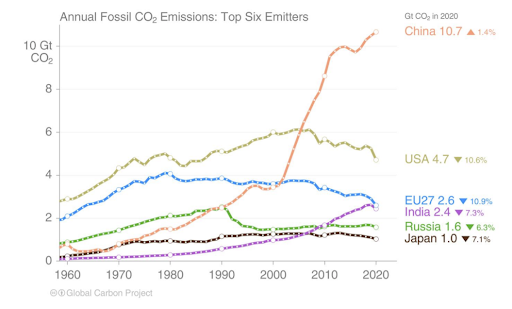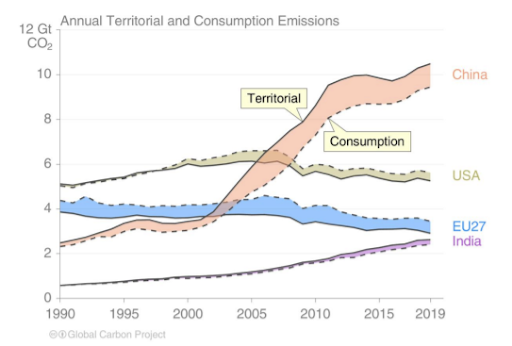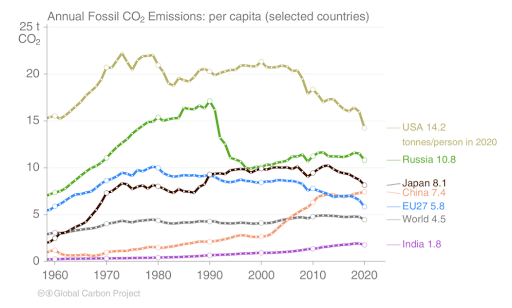One unexpected moment occurred at COP26 earlier this week, when China and the United States I pledged to work together to accelerate climate action.
The announcement by the world’s two largest emitters of greenhouse gases was light on concrete goals but was a powerful symbol of increased cooperation between the two giants on climate change.
The United States has already said it plans to be carbon neutral by 2050, while China said last month that it intends to reach net zero emissions before 2060.
But how do the two countries compare to the rest of the world when it comes to carbon dioxide emissions?
Global warming is gas. Or rather, several gases. Carbon dioxide (CO2) accounts for about three-quarters of global greenhouse gas emissions, but there’s also methane, nitrous oxide, and a few other bits and pieces.
In practice, comparisons between countries tend to focus on carbon dioxide, as it is the largest and the easiest to get up-to-date figures.
Source: Our World in Data
There are various ways to analyze which countries are responsible for the most emissions, but in absolute numbers alone, China is by far the largest producer of carbon dioxide emissions in the world, followed by the United States, the European Union, India, Russia, and Japan. It was also the only one among those major emitters that increased emissions during 2020.
Source: Global Carbon Project
Annual carbon dioxide emissions from China rose 1.4% last year to 10.7 billion tons, nearly a third of the global total. to me New data from the Global Carbon Project. It is followed by the USA with 31% of global emissions with 14%, the European Union (7%), India (7%), Russia (5%) and Japan (3%).
“China recorded a year-over-year increase in emissions in 2020 and was by far the only country to do so,” says Lauri Myllyvirta, senior analyst at the Center for Energy and Clean Air Research, a think tank.
“What happened is that the government did what it had always done in response to negative economic shocks: it started a huge number of construction projects and expanded lending for real estate development. They basically used the more carbon intensive sectors of the economy to boost the GDP numbers.”
Chinese construction boom – which now looks like it The address can be For ghost territory – it helped ensure that global emissions fell only 5-6% last year, despite the pandemic.
It is often pointed out that China produces a lot of export commodity emissions for countries like the United States, which should take responsibility for the carbon dioxide generated. Running the numbers on «consumption» rather than «regional» narrows the gap a bit, but it makes less of a difference than you might think: China is still far ahead of the US and the rest of the world.
Source: Global Carbon Project
«Since the global financial crisis, increases in China’s emissions have been really driven by domestic demand» rather than exports, says Mylvirta. The country also imports much more than it once did, equaling the emissions it “exported.”
What is driving China down the rankings is the division of emissions by population. The worst offenders Small oil-rich countries such as Qatar, Kuwait and Bahrain. Ireland does not have much success with this procedure either, as The Good Information Project Explore it last week.
Among the six largest emitters, most CO2 per capita comes from the United States (14.2 tons), followed by Russia (10.8), Japan (8.1) and only then China (7.4), roughly the same as Ireland. The 28 EU countries as a whole came in at 5.8, with India down by 1.8.
No news is bad news
magazine support
is yours contributions You’ll help us keep delivering the stories that matter to you
Support us now
Source: Global Carbon Project
Still another way to think about emissions, given that CO2 has been around for a long time, is to determine which countries have produced more over time rather than in any particular year. The United States, the European Union, and the United Kingdom, which were earlier industrial, were responsible for nearly as much carbon dioxide now as the rest of the world combined.
“To the extent that these countries reaped the economic benefits of early industrialization, they have a financial responsibility to support those countries that face additional constraints on their development,” says Mylvirta.
But he argues that Western governments should not necessarily be in trouble over emissions before global warming is recognized as a problem. Emissions since then, and certainly since climate change treaties, are a different story.
The first time rich nations promised to cut emissions was in Rio in 1992. These promises largely went unfulfilled. US emissions only peaked in 2006, when they were actually supposed to decline between 1990 and 2000.”
However, there is no way to solve the problem of climate change that is done only through the developed countries. China is a middle-income country and the largest emitter in the world. «There is no practical way to reduce global emissions as long as China continues to increase its emissions,» Mylvirta points out. «Everyone needs to step up.»
Carbon dioxide isn’t the only contributor to global warming. Other greenhouse gases such as methane play a major supporting role. So does deforestation, which puts countries like Brazil and Indonesia in the frame. But for comparisons across countries globally, CO2 emissions from energy and cement production tend to be used the most in practice, as they are the largest contributor and the easiest to get reliable and up-to-date figures around.
This work is co-funded by Journal Media and a grant program from the European Parliament. Any opinions or conclusions expressed in this work are those of the author. The European Parliament does not participate in and assumes no responsibility for the editorial content published by the project. for more information, look here.

«Lector profesional. Jugador galardonado. Aficionado a los zombis. Adicto a las redes sociales. Experto en tocino. Erudito en Internet»


